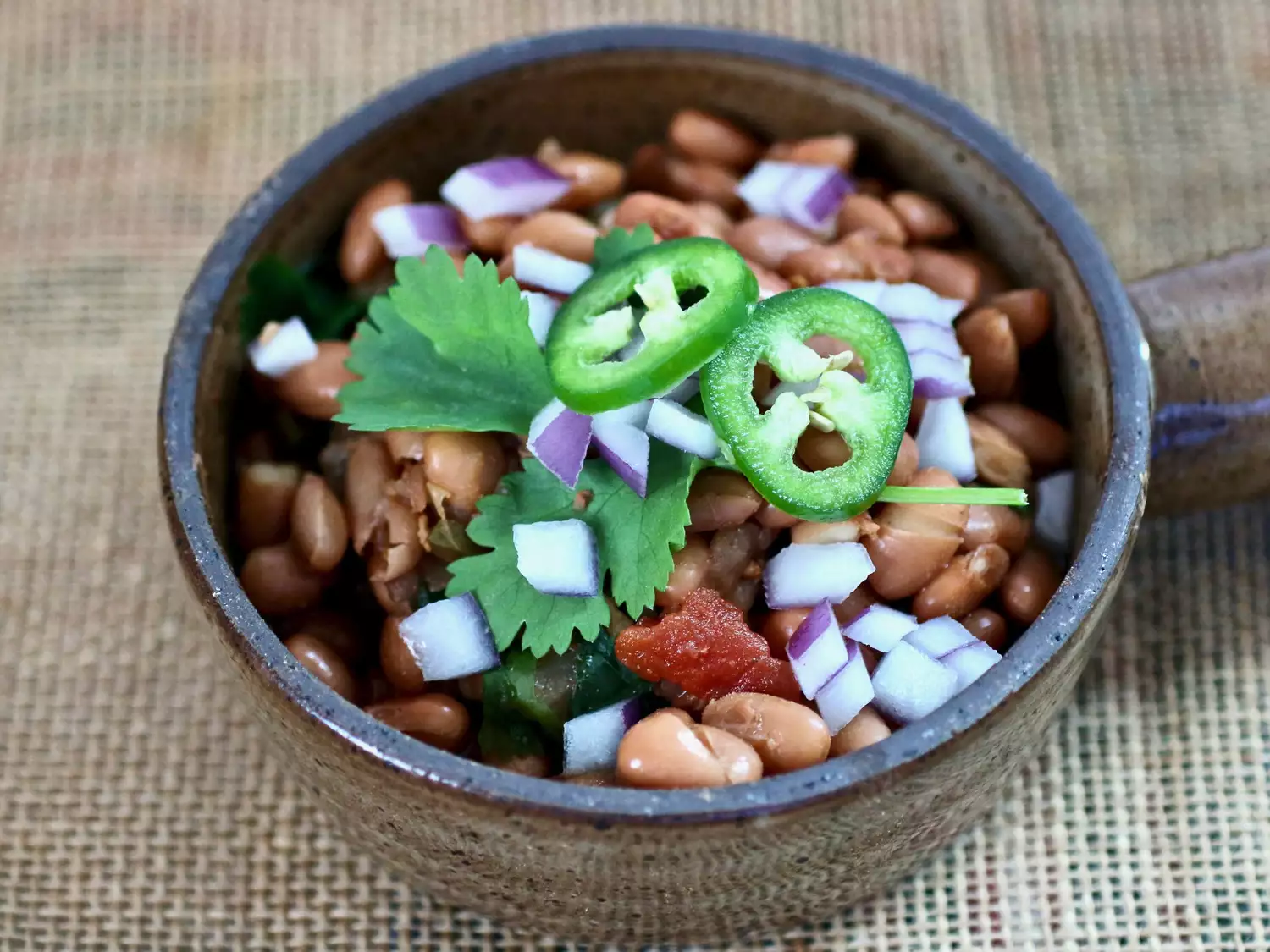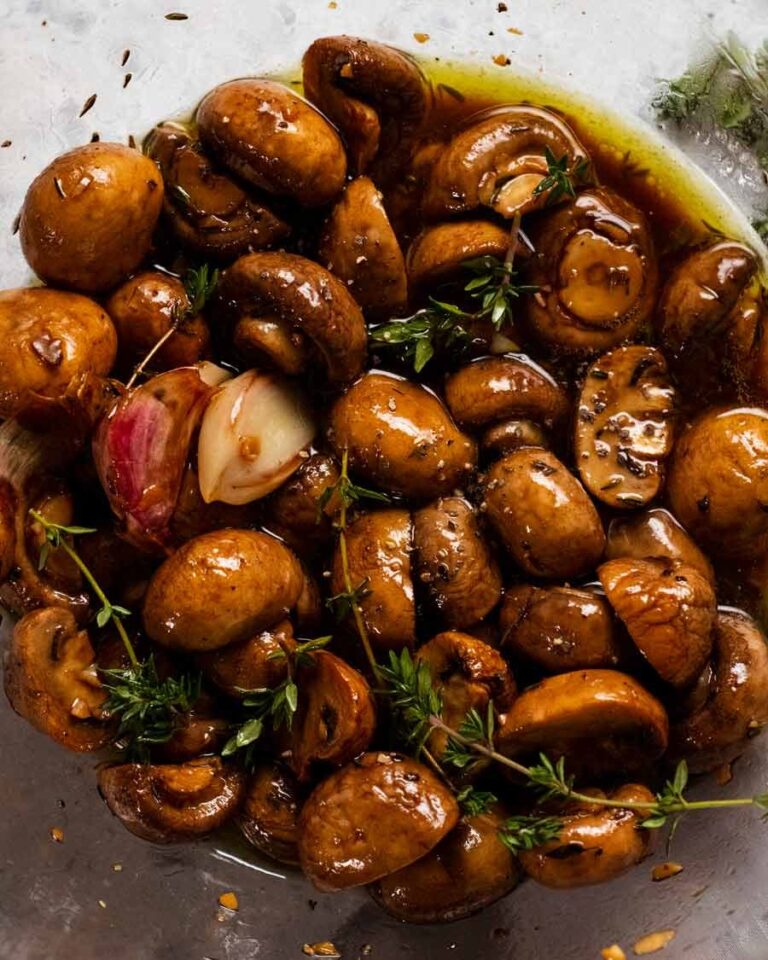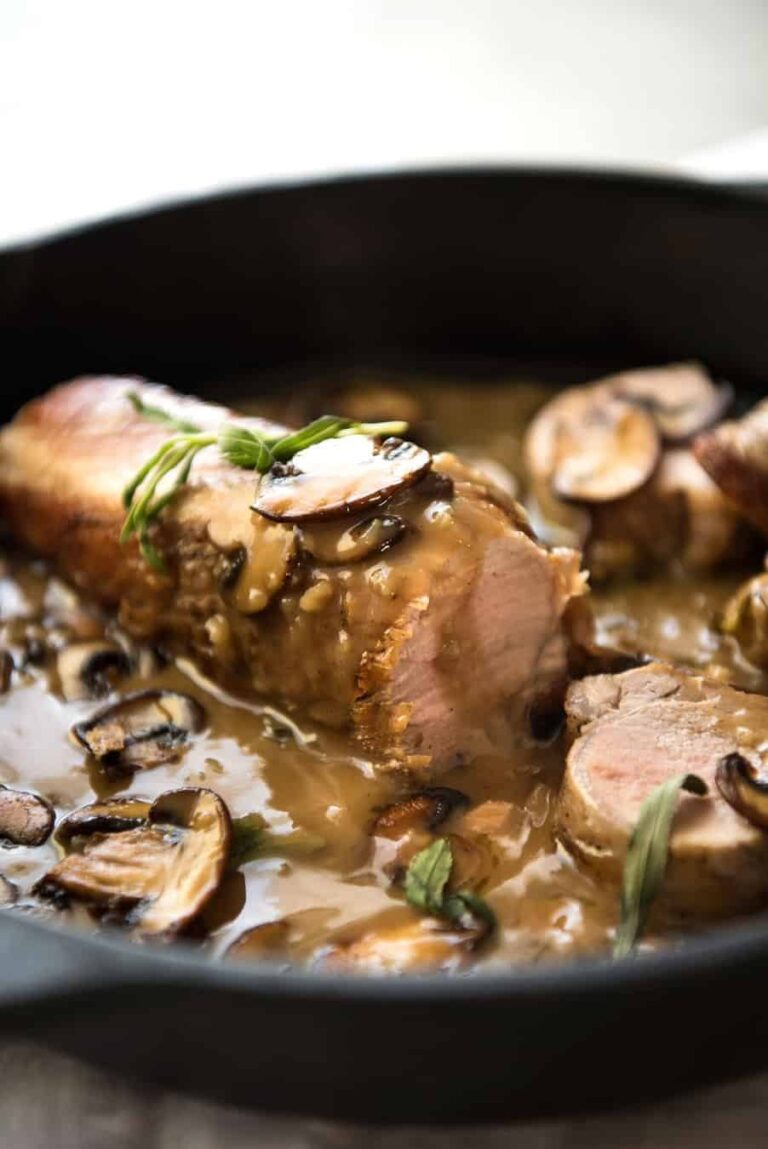
Chicken stock Recipe
That is the one chicken inventory recipe you’ll ever want. It’s a superb all-rounder that’s good and clear, with the perfect steadiness of flavour, vitamins and richness. Use it for every thing from clear soups to wealthy stews, gravies and creamy sauces.
I like making chicken inventory as a result of it’s straightforward in comparison with beef inventory, and improves nearly every thing – the primary objective right here!
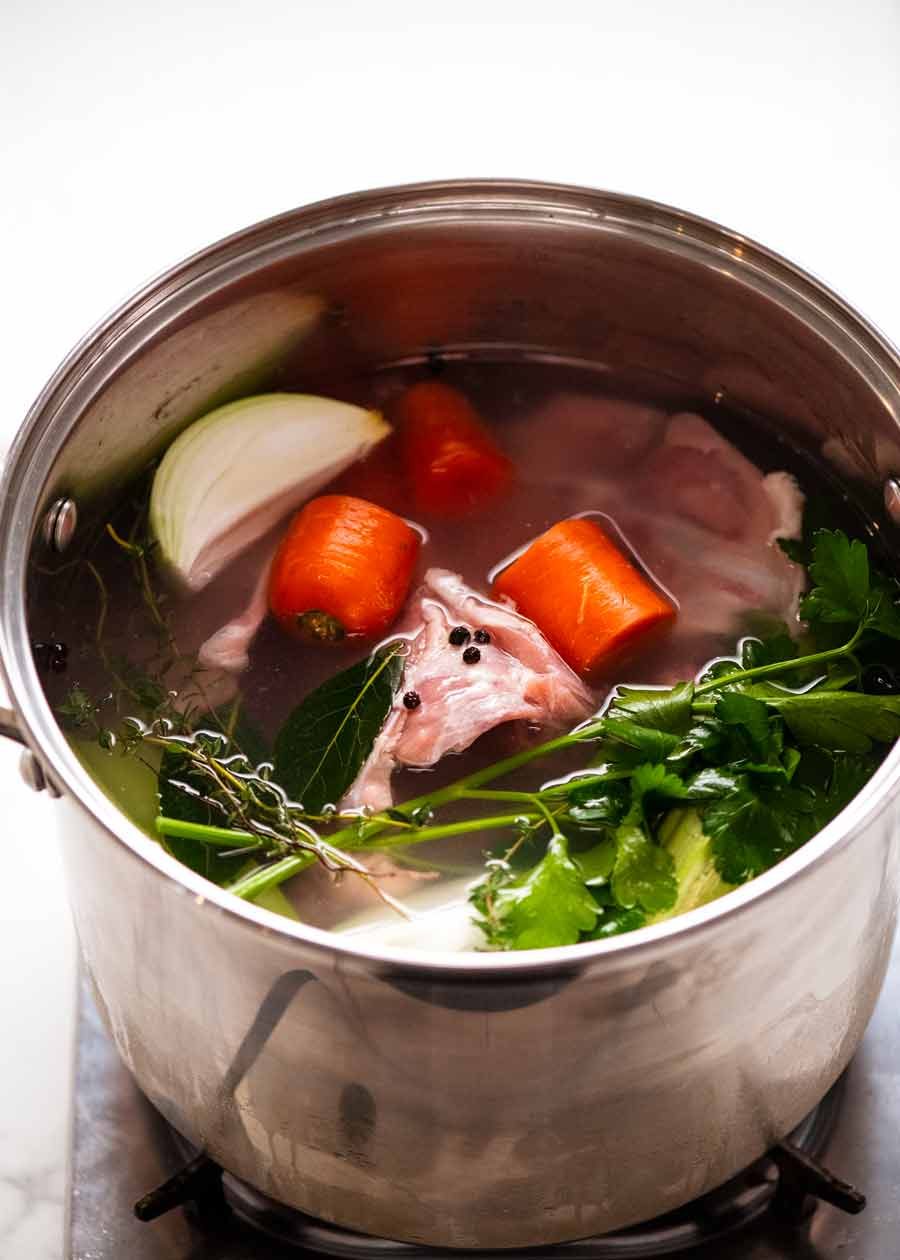
Shares are the muse for numerous dishes in lots of cuisines. Chicken inventory is likely one of the commonest and versatile shares in Western cooking, and is made by infusing water with the flavours of chicken, contemporary root greens and herbs. Good eating places all the time make their very own shares, and is the key to why their dishes typically have that richer, deeper, “restaurant-quality” style to them!
Should you’re not satisfied why you’d trouble making do-it-yourself chicken inventory, let me persuade you:
-
Higher flavour – Retailer-bought inventory doesn’t examine to actual, freshly made inventory. Only one style is all it’s essential know this!
-
Richer mouthfeel – Home made chicken inventory has considerable gelatin from the chicken bones and tissues, which supplies it a full-bodied richness and mouthfeel when utilized in soups and stews. Retailer-bought inventory lacks this high quality.
-
Extra versatile as a result of it’s unsalted – Retailer-bought inventory is sort of all the time salted. That is high quality when used at regular concentrations, but when inventory is decreased rather a lot when making ragus, sauces and so forth, the salt can turn out to be extreme – but there may be little you are able to do about it. Home made inventory however is unsalted, so you’ll by no means have this drawback and may management seasoning within the completed dish.
-
Making jus and reductions – Superb eating discount sauces akin to jus rely closely on the pure thickening energy of gelatin to create that luscious, silky consistency. You’ll be able to scale back a store-bought inventory 90% however, and it’ll nonetheless be watery!
-
It’s surprisingly low-effort – Whereas I’m the primary to admit that beef inventory does require dedication and many time to make (but it surely’s value it!), chicken inventory is far much less upkeep. Simply plonk every thing in a pot and let it simmer for 3 hours, and pressure!
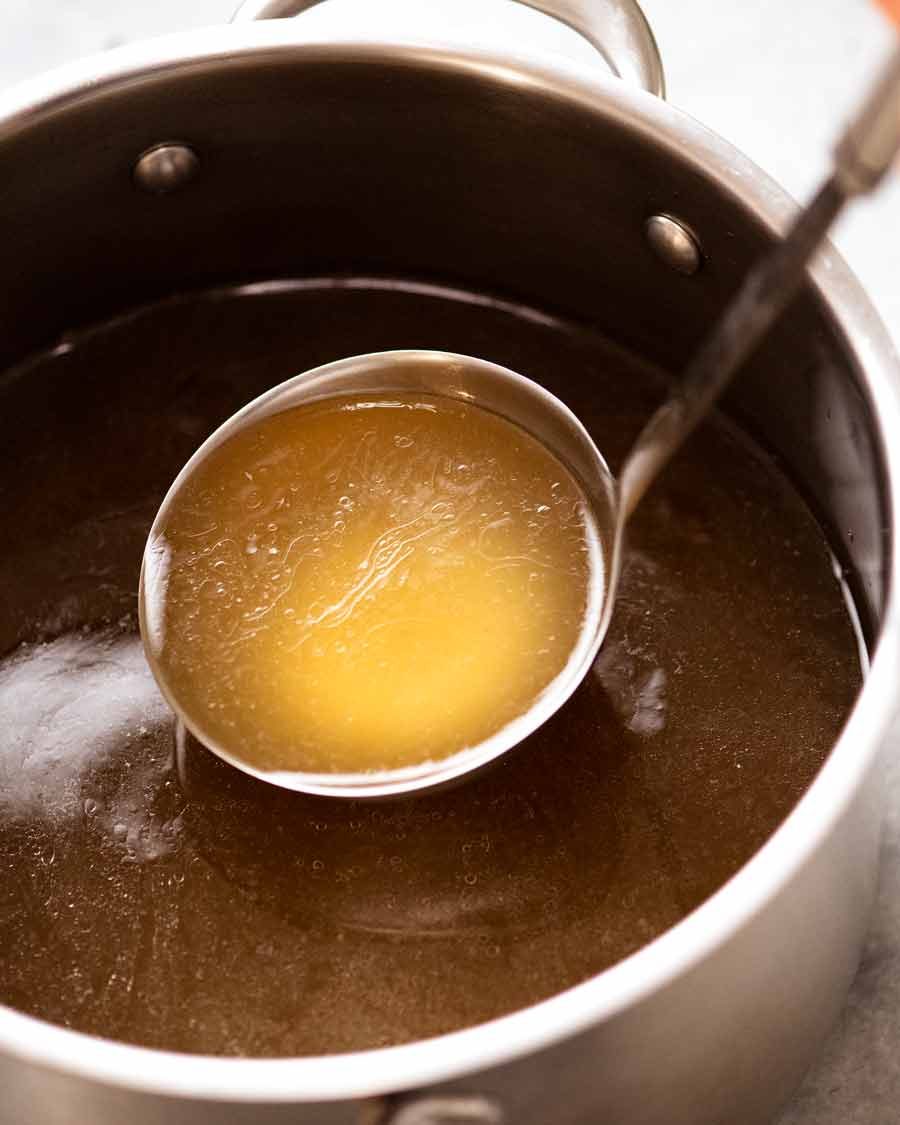
I exploit chicken bones to make chicken inventory. I discover that it makes an ideal all-rounder, clear inventory with good flavour at store-bought energy. Particularly, I exploit chicken carcasses, also referred to as chicken frames, (see photograph under) which litre for litre are essentially the most economical minimize.
What’s a chicken carcass? A chicken carcass are the bones and cartilage “body” of the chicken after all of the meat has been minimize off (breast, drumsticks, thighs, wings). There’s often a good quantity of meat left on it, but it surely relies upon how nifty the butcher is along with his knife abilities! The steadiness of meat, bone and residual fats on a chicken carcass provides a superb steadiness of flavour, precious vitamins and collagen, in addition to making a pleasant clear inventory. They’re available right here in Sydney from butchers and even grocery shops.
Some recipes will choose to make use of chicken items with meat and pores and skin to make inventory. I share my ideas on this under! (Spoiler: I don’t agree!)
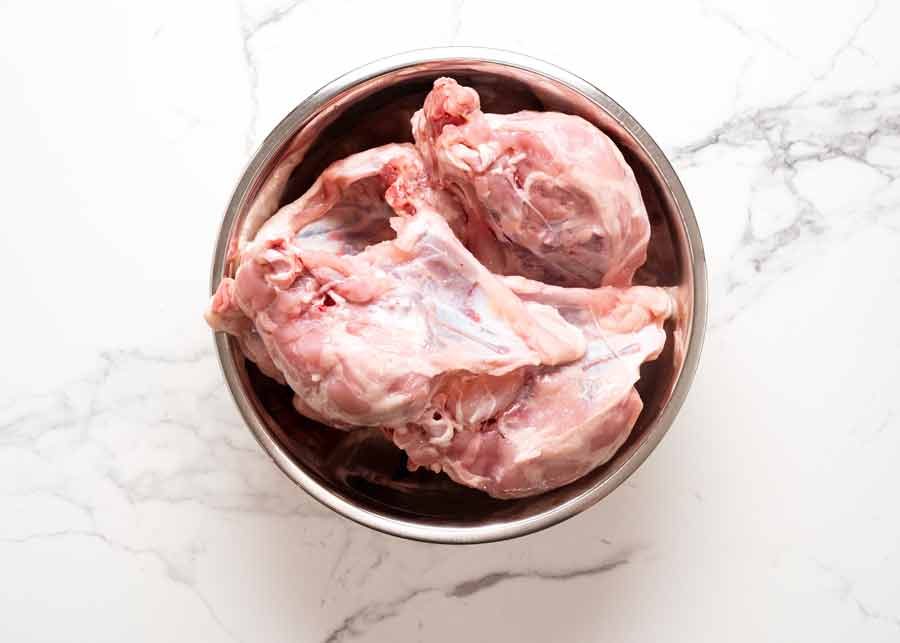
Why I don’t use different chicken cuts for inventory
Listed below are my ideas on different chicken cuts which can be typically used for chicken inventory:
-
Breast – I simply assume it’s wasteful. The cooked chicken is flavourless and stripped of all diet, as a result of it’s given up all its goodness to the inventory. So you possibly can’t actually use the spent meat for something besides perhaps filler in strongly flavoured meals, or maybe giving it to your canine! Additionally, as a result of chicken breast is pretty impartial in flavour, you want rather a lot to extract sufficient flavour to make a good inventory.
-
Pores and skin-on, bone-in chicken items, like thigh and drumsticks – Whereas they make very flavourful shares, the pores and skin and fats makes the inventory greasy and there can be fairly a slick of oil floating on prime of the inventory. This can be a little too fatty for a lot of functions, akin to making good clear chicken noodle soups.
-
Wing ideas – Wing ideas are full of gelatin and flavour, being a darkish meat. Should you’ve received some, throw them in! However to make a complete batch of chicken inventory, you’d want a LOT of wing ideas.
-
Chicken toes – It will add lots of gelatin into the inventory so it wouldn’t harm to throw some in (say 4 to six) for further richness. I feel should you made a complete batch of inventory utilizing simply toes it will be far too gelatinous!
-
Complete chicken – I discover that you would be able to’t extract sufficient flavour from a complete chicken for the quantity of water required to cowl it utterly to make a correct flavourful inventory. Actually, even when making a standard chicken noodle soup utilizing a complete chicken, I all the time add a small contact of inventory powder to provide the soup inventory just a little enhance. In any other case, it’s only a bit bland!
-
Giblets – Giblets refers back to the coronary heart, liver and gizzards of chicken which can be typically bundled up and stuffed contained in the cavity of retailer purchased entire chicken. They’re supplied with the intention to make gravies and sauces. You probably have some, by all means throw them in with the bones! I might not make a inventory with only a massive bag of giblets nonetheless, as will probably be fairly offal-ly!
-
Body of cooked entire chicken – The carcass of a roast chicken won’t present sufficient flavour for do-it-yourself chicken inventory. I’ve tried a number of occasions through the years! You simply can’t get almost sufficient flavour out of it for the quantity of water required to cowl it.
Listed below are the opposite elements in do-it-yourself chicken inventory:
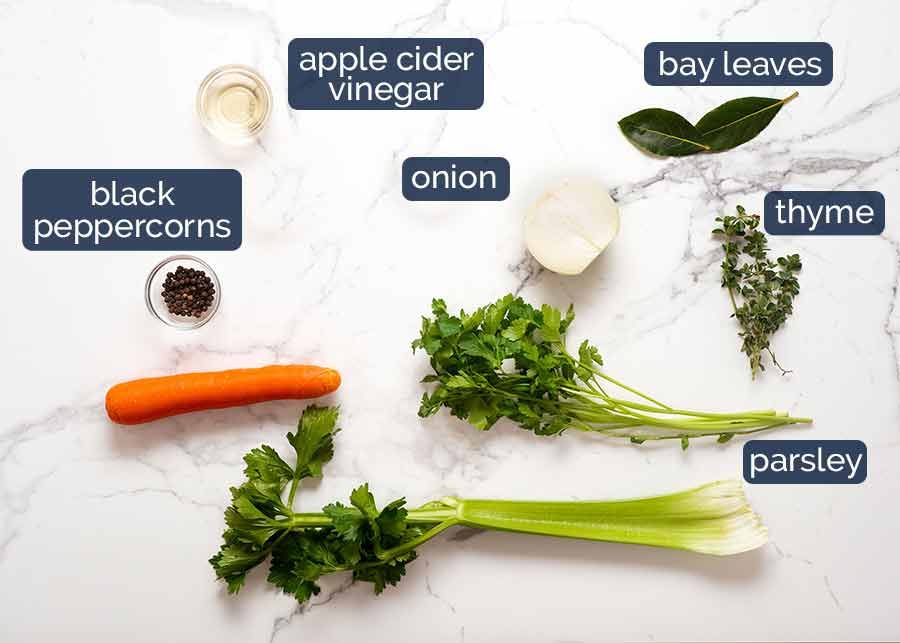
-
Bay leaves, thyme, parsley, black peppercorns – Herb and spice aromatics, a reasonably commonplace choice for many shares together with beef inventory and vegetable inventory.
-
Onion, celery and carrot – Once more, acquainted building-block elements in most shares and lots of Western dishes. The basis greens add refined sweetness in addition to a freshness and complexity to the inventory.
-
Cider vinegar – A bit of vinegar helps extract vitamins from the bone. We solely use a splash, you can not style it nor does it make the inventory discernibly bitter in any respect.
A brown inventory refers to a inventory the place the bones are roasted and the tray deglazed earlier than simmering, as you’d do with beef inventory. A brown chicken inventory has a deep, advanced, roasted flavour in addition to a darker color.
A white chicken inventory however simmers uncooked bones. The result’s a cleaner, extra neutrally flavoured and fresh-tasting inventory that’s total extra versatile for cooking – versatile sufficient for use even with seafood or non-chicken meat dishes, akin to Fish Chowder. That is the kind of inventory that’s mass produced and bought at grocery shops, and it’s the kind of inventory we’re making at this time.
As a result of we’re making a pleasant clear white chicken inventory (see above), there’s no bone-roasting malarkey to deal with first which makes the entire course of a lot faster and fewer laborious. Simply dump every thing in a pot, add water and simmer!
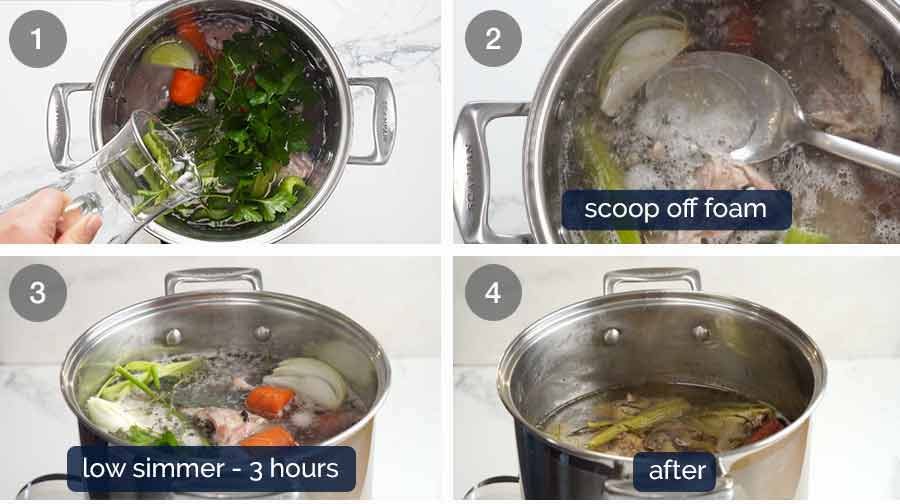
-
Put every thing in a big inventory pot – Place the chicken carcasses, greens, herbs and water in a big 7 litre /7 quart inventory pot. 3 litres / 3 quarts of water ought to nearly cowl every thing. If not, do a little bit of pushing and poking to rearrange the carcasses and elements extra snugly within the pot. Attempt to not break or crush the bones else this can make the inventory murkier.
We wish every thing submerged so the water will get infused with flavour. Don’t fear if among the bones are poking above the water floor. The carcasses will collapse as soon as it begins cooking and find yourself below the water.
-
Scoop off scum – Convey the pot to a fast simmer over medium-high warmth. Because it begins getting scorching, you will notice foam on the floor which is the impurities within the chicken. Scoop it off and discard to maintain your inventory good and clear.
-
Simmer 3 hours – As soon as the water involves a fast simmer, decrease the warmth so it’s effervescent very gently. Then go away to simmer for 3 hours with the lid off.
-
After simmering – The photograph above reveals the water degree after 3 hours. It has decreased by round 1/3.
Your chicken inventory is completed! Now we simply must pressure it, take away extra fats (in order for you) and retailer it! Right here’s how:
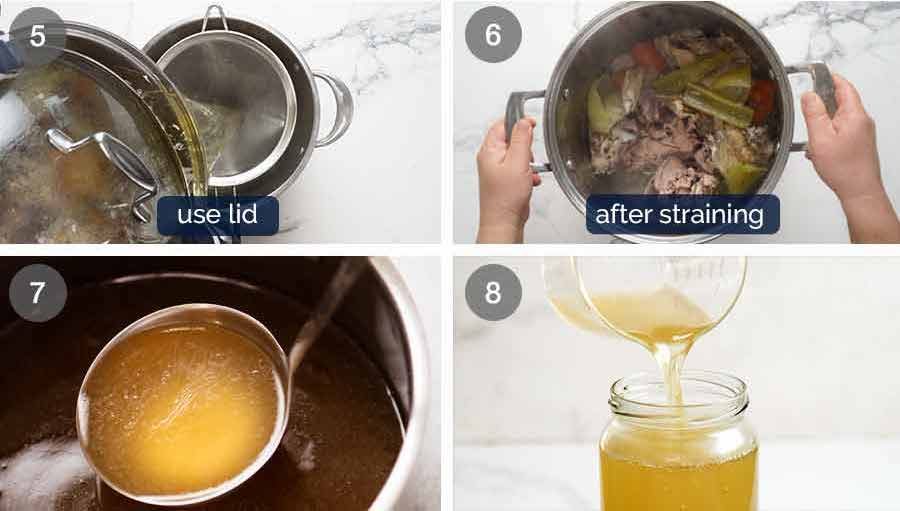
-
Pressure – Utilizing the lid of the pot to carry again the bones and greens within the pot, pressure the inventory via a high quality mesh strainer into one other pot or giant bowl. I exploit a pot in case I want to scale back it to the correct quantity (see under)..
Should you’re not sturdy or snug with the lid technique, simply fish out the solids with tongs or a big straining spoon earlier than pouring the remaining liquid via a sieve.
The objective: To finish up with 2 litres / 2 quarts of chicken inventory. In an ideal world, you’ll find yourself with 2 litres / 2 quarts of chicken inventory. However it’s not often an ideal world! And that’s okay. You probably have much less, than this simply prime up with water. Should you ended up with greater than about 2.25 litres / quarts, then scale back it on the range, else you run the danger of a weak-flavoured chicken inventory.
-
Voila! Admire your stunning and clear chicken inventory!
-
Divide between storage containers – At this level, I divide the top off into jars or containers which permits the inventory to chill sooner.
I retailer my chicken inventory in 1 cup multiples which I discover fairly helpful to be used. All the time label your containers with the amount of chicken inventory and date you made it!
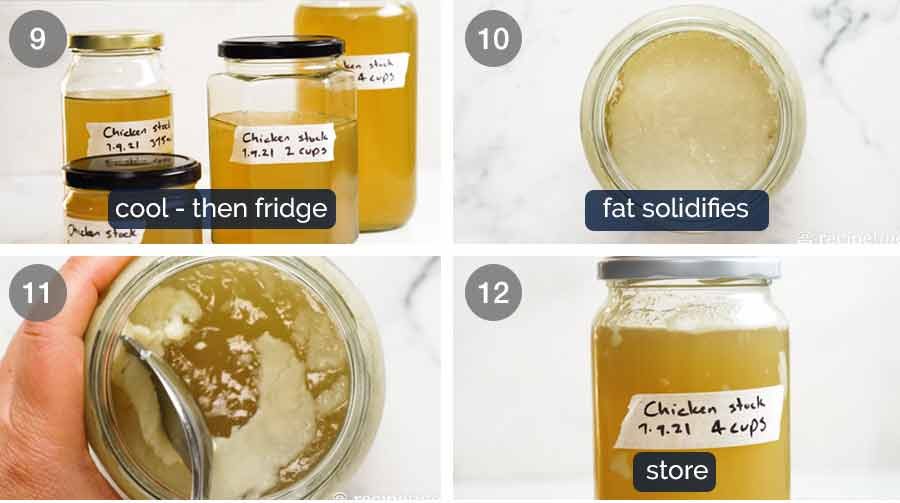
-
Cool then refrigerate – As soon as the inventory is cooled to room temperature, place them within the fridge to totally cool. By no means put scorching inventory within the fridge!
-
Solidified fats – Because the inventory cools, the fats will rise to the floor. As soon as totally chilly, the fats solidifies and turns right into a white sheet of stable fats on the floor of the inventory, like a frozen-over lake.
Additionally, you will discover that the chicken inventory corporations up right into a jelly-like consistency when chilly. That is as a result of gelatin. We need gelatin – it’s what provides the inventory a scrumptious, lip-sticking, wealthy mouthfeel you don’t get in store-bought inventory (ever discover how store-bought inventory by no means units like this within the fridge?) So mainly, jelly consistency = good inventory!
-
Scrape off fats – Scrape the fats off the floor utilizing a spoon and discard. That is truly an elective step. It makes the inventory mild and clear, making it an ideal all-rounder that can be utilized for every thing from clear soups (like Chinese language Noodle Soup) to wealthy sauces (just like the sauce of a Creamy Chicken Pasta). For a jus or discount sauces you must also use de-greased inventory.
However if you’re intending to make use of the inventory for issues like stews (like this one) and creamy sauces (like Mushroom Sauce) that don’t require a transparent, de-greased chicken inventory like we want for issues like Chicken Noodle Soup, then there isn’t a must take away the fats.
-
Storing – Home made inventory will maintain for five days within the fridge or for six months within the freezer.
Fridge-cold chicken inventory can be utilized as is, in its jelly-like state. It melts again into liquid kind in a short time as quickly because it’s heated.
If utilizing from frozen, thaw in a single day within the fridge, microwave, or run the container below scorching water to loosen, then soften in a saucepan. Although if I’m including the inventory into an already-simmering liquid typically I’ll simply add the frozen inventory block as-is! It melts pretty quick and the end result is similar. I exploit all of those strategies relying on how a lot time I’ve!
Right here’s a jar of refrigerated chicken inventory which has had the fats scraped off the floor.
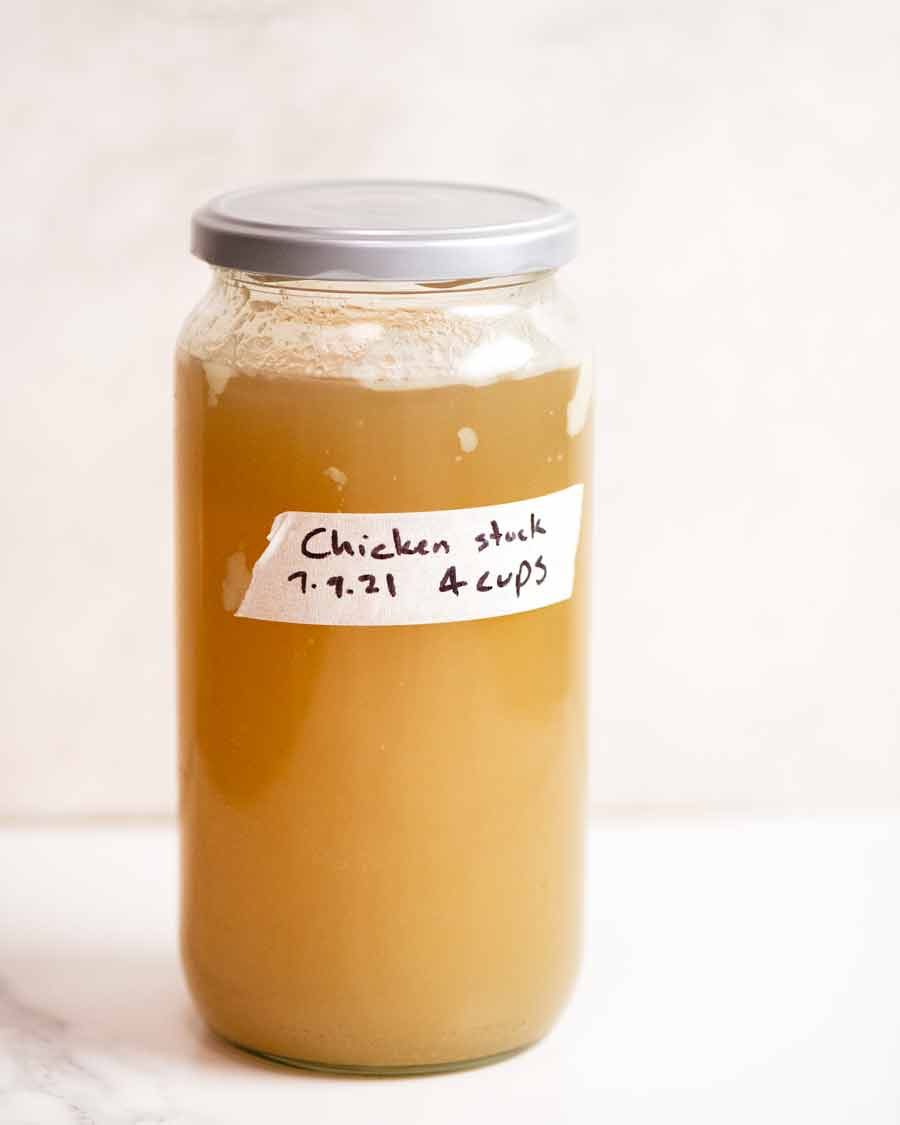
And right here it’s in liquid kind at room temperature. However as famous above, you possibly can simply use chicken inventory in jelly kind because it melts in seconds on contact with warmth!
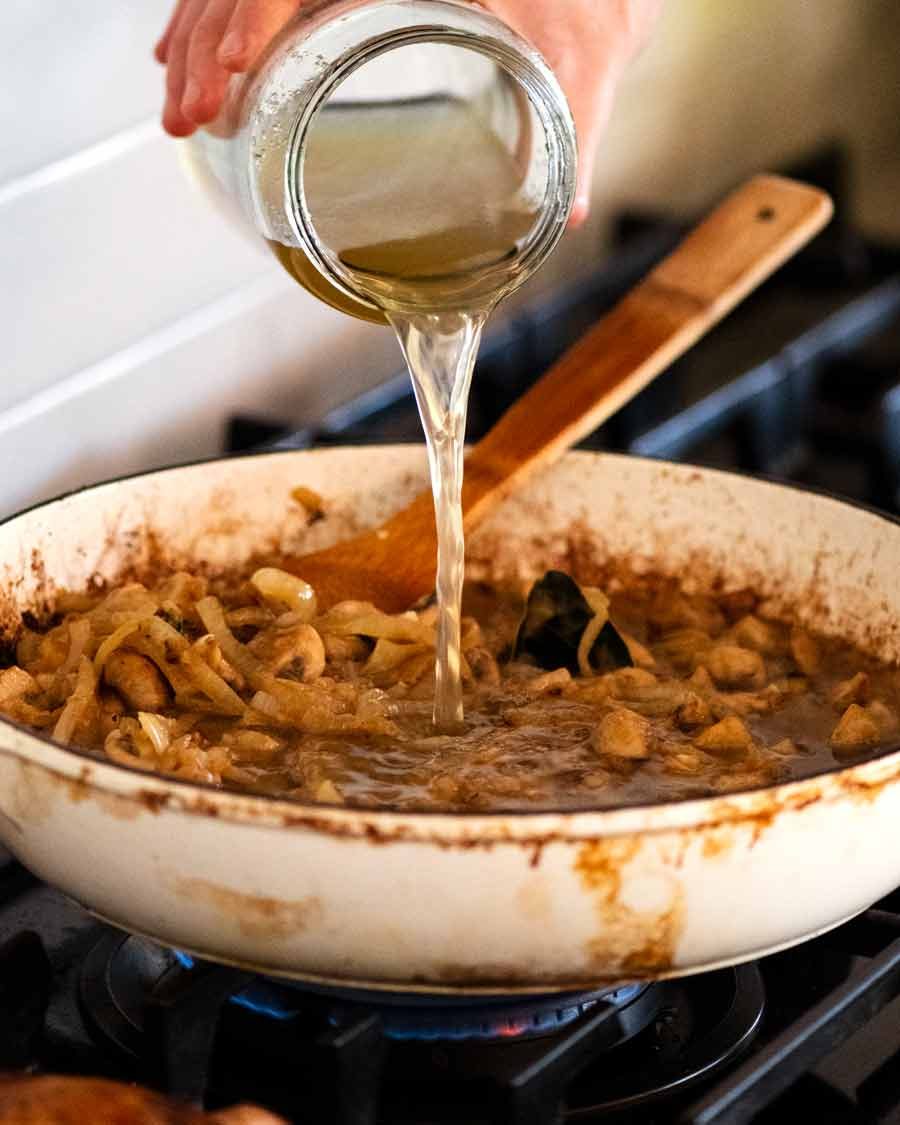
This do-it-yourself chicken inventory can be utilized for any recipe that requires chicken inventory. It should elevate any dish from nice do-it-yourself meals to top-notch, restaurant-quality in style, consider me!
Home made inventory significantly makes a distinction in dishes the place the standard and flavour of the inventory can shine. In different phrases, dishes that aren’t closely flavoured with spices, seasonings or a heavy dose of cheese! Some concepts:
-
Rice dishes – Rice is a sponge for all that scrumptious inventory in Mushroom Rice, Paella, Jambalaya and Oven-baked Chicken and Rice.
-
Clear soups – The pure flavour of the inventory shines in Chicken Noodle Soup, Wonton Soup or Chinese language Noodle Soup
-
Vegetable soups – It additionally provides actual depth to easy vegetable soups, like Mushroom Soup, Minestrone, Pumpkin Soup, Leek and Potato Soup.
-
Stews and braises – Home made inventory raises any stew to restaurant-quality ranges! Chicken is an apparent alternative: Say Chicken Pot Pie, Chicken Tetrazzini or Chicken Stew with chicken inventory. However chicken inventory can equally carry different meats in a braise – Fish Chowder Soup and even Beef Bourguignon. And I truly intentionally use chicken inventory over beef inventory for Irish Guinness Stew, for higher flavour.
-
Sauces and gravies – A world aside when made with do-it-yourself inventory, whether or not it’s Turkey Gravy, Fast Gravy or a whole pan bake like Sausages with Potatoes and Gravy. In the meantime a correct jus wants a correct inventory, and this superb Vermouth Jus might be made with chicken as an alternative of beef inventory.
On Wednesday, I’m going to be sharing a recipe that basically advantages from do-it-yourself chicken inventory. It’s nice made with retailer purchased, however when made with do-it-yourself, it takes it to company-worthy! – Johnsat x

Ingredients
- 2 kg/ 4 lb chicken frames (ie carcass) , raw (Note 1)
- 1 carrot (medium), unpeeled, cut into 4 equal pieces
- 1/2 onion , peeled and halved
- 1 celery stem , cut in four (use the leaves too)
- 1/2 tbsp black peppercorns
- 1 tbsp apple cider vinegar (Note 2)
- 2 bay leaves , fresh (or 1 dried)
- 2 thyme sprigs (or 1/2 tsp dried leaves)
- 3 parsley sprigs
- 3 litres / 3 quarts water (just tap water, cold)
Instructions
- Fill pot: Place all the chicken stock ingredients into a large stockpot (7 litre / 7 quarts+). Fill with 3 litres / 3 quarts of cold water, which should just about cover the bones. (Note 3)
- Scoop off scum: Bring to a boil on medium-high heat. Scoop off and discard any foam that collects on the surface using a ladle (this helps make stock clear).
- Simmer 3 hours: Turn stove down to low and simmer for 3 hours with no lid. The stove should be low enough so the surface is barely rippling and you just get a gentle bubble every now and then. Too rapid boiling = murky stock.
- Strain: Using a lid to hold the bones and vegetables in the pot, pour the stock through a fine sieve into another pot or large bowl. (Alternatively, scoop out the solids first with a slotted spoon and then strain.)
- Goal: You should end up with 2 litres / 2 quarts of stock. If you have more than about 2.25 litres / quarts, reduce by simmering on low (else the stock will be too weak). If you have less than 2 litres / quarts, top up with water.
- Fill jars/containers: Measure out into containers for storage and faster cooling. (I do multiples of 1 cup)
- Cool: Allow to cool on the counter then refrigerate. This will make any fat rise to surface and solidify.
- Discard fat: Scrape fat off the surface and discard.
- Ready to use! This stock is equivalent in strength to store-bought stock, so it can be used 1:1 in any recipe calling for chicken stock.
- Store for 5 days in the fridge or freezer for 6 months. (Note 6)
- Salt adjustment (Note 5): Homemade stock is unsalted whereas store-bought stock is salted. Add 1/4 tsp salt for every 1 cup homemade chicken stock (250ml) to match the salt level of store-bought low sodium chicken stock.
- To use: Cold stock has a jellied consistency (Note 4). It takes barely a minute to turn liquid on a medium-high stove, or microwave. You can also just add it in jelly form straight into dishes, but sometimes you may need to liquify it to measure.
Notes
1. Chicken carcasses – This is the chicken frame (bones and cartilage) after the meat has been cut off (breast, drumsticks, thighs, wings). Economical and readily available here in Sydney (butchers, even grocery stores), it’s my preferred choice because:
the proportions of meat, bone and residual fat gives an excellent balance of flavour, valuable nutrients and collagen
it makes a nice clear stock that is an ideal “all rounder”.
Other chicken cuts can be used but yields stock with different characteristics eg. skin-on bone-in chicken pieces (thighs, drumsticks) will be fattier and murkier. See in post for more information.
Carcass of roasted chicken after removing the cooked meat not recommended – does not yield enough flavour.
2. Cider vinegar – Helps extract nutrients out of the bones. You cannot taste it nor does it make the stock sour.
3. Fitting in pot – Arrange the bones and vegetables so they fit snugly, but don’t crush / break the bones as this will tend to make the stock murky. The water should just about cover the bones. Don’t worry if they are sticking out a bit, they will collapse as they cook.
4. Stock consistency – When cold it will turn to a soft jelly like due to gelatin. Gelatin gives the stock richness that you don’t get in liquid store-bought stock. Gelatin is good! So, jelly is good : )
5. Salting – Homemade stock is not salted, so it can be massively reduced to make things like jus without becoming too salty. You cannot make fine sauces like jus using store bought stock. Note however that homemade chicken stock has a small amount of natural salt. If you reduce it by say 90% or more, you will begin to taste it. Think of it as natural seasoning!
6. Storing – Homemade stock will keep for 5 days in the fridge or for 6 months in the freezer.
Fridge stored: When fridge-cold, it becomes gelatinous (jelly-like) from the collagen in the bones. This is good! It means it’s rich with gelatin, which gives the dishes we use it in a luscious, lip-sticking quality. It’s fine to use as a jellied stock, it will immediately melt back to liquid when heated.
Frozen: Either thaw overnight in the fridge, microwave, or run the container under hot water to loosen then melt in a saucepan. Sometimes if I’m adding the stock to a simmering liquid I’ll just throw it in frozen! It melts quite quickly and the end result is the same. I use all methods depending on how much time I have!



